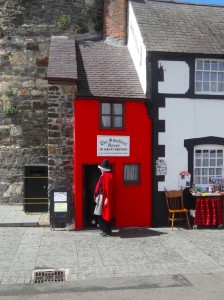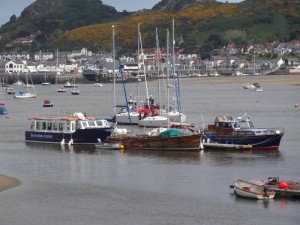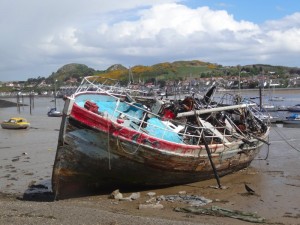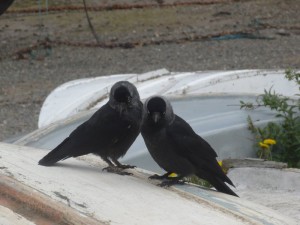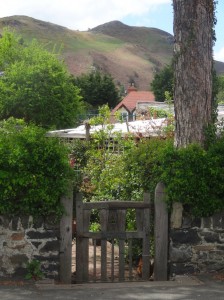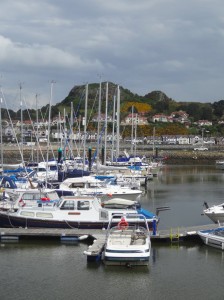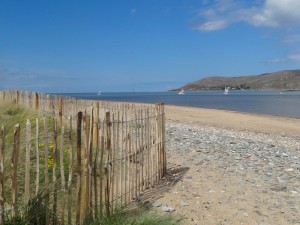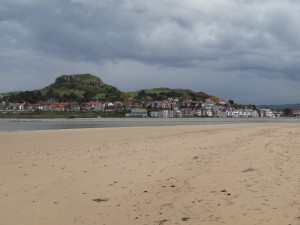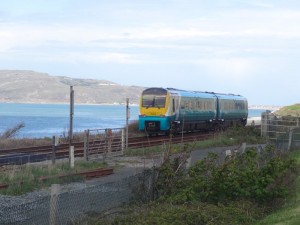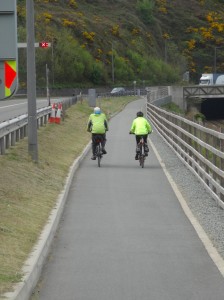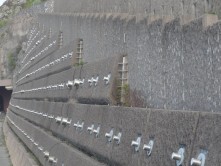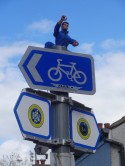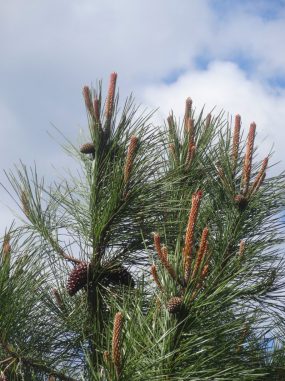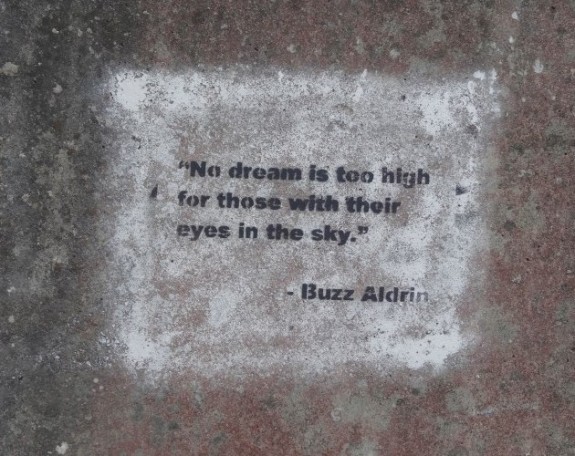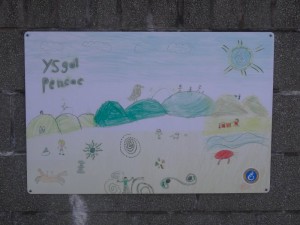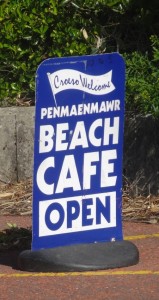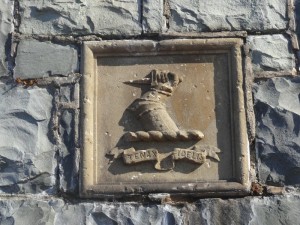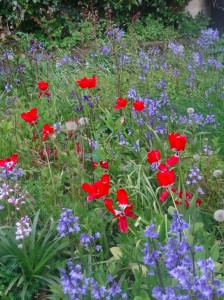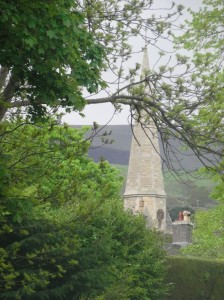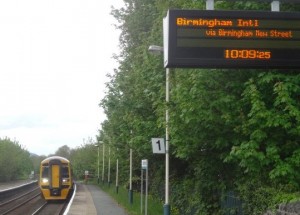 After starting the day with some writing, I took the 10:09 train, which rolled in exactly to time. You could set your watch by the eastward North Wales service. By the time I found somewhere for breakfast in Conwy and ate it, it was after eleven. The night before I had come over the bridge below the castle. This was one of the string of castles built in the 12th century to subdue the Welsh. As well as the castle itself, the town wall is remarkably intact, and it is a World Heritage Site. Such was the fear of the Welsh that only English people were allowed inside the walled town until 1487 when Henry Tudor came to the throne.
After starting the day with some writing, I took the 10:09 train, which rolled in exactly to time. You could set your watch by the eastward North Wales service. By the time I found somewhere for breakfast in Conwy and ate it, it was after eleven. The night before I had come over the bridge below the castle. This was one of the string of castles built in the 12th century to subdue the Welsh. As well as the castle itself, the town wall is remarkably intact, and it is a World Heritage Site. Such was the fear of the Welsh that only English people were allowed inside the walled town until 1487 when Henry Tudor came to the throne.
I rejoin the Coast Path along the quayside, passing a sculpture of mussels, and (somewhere nearby but I missed) the Mussel Museum. Mussels were originally gathered for pearls, but later became a culinary export for the town. On the quayside is also the hull of a boat, an old ‘nobby‘ in the midst of repair. The project is similar to the Tiree Maritime Trust, except nobbies are far larger than traditional Tiree boats.
A little further on is ‘The Smallest House in Britain‘, originally fitted into a tiny gap between two existing buildings, one of which has since been demolished. As a campervan owner, I appreciated the care in the layout, everything has its place and where possible multipurpose. The house itself is barely six foot by five, and the last occupant, at 6 foot 3, used to sleep with his feet sticking out of the window.
Only a few hundred yards into walking properly I looked at my phone to check the time and realised there was a series of missed calls and voicemails from Robert Thomas of Radio Wales News wanting to interview me on the move. So, back to Conwy to meet up, starting the interview by the waterside and then walking together and answering questions on the move. For this interview, Robert was principally interested in the technology aspects and issues of poor or intermittent connectivity. It is an issue that comes up a lot in listeners’ letters and that Robert suffered from himself when trying to upload short news summaries using a phone app. For him it was reliability that was key.
During the interview I said that a lot of the problems were due to hardware and software developers in Silicon Valley simply not realising what real-world connectivity is like, even in major cities, let alone rural areas. Flickr Uploader is one application that annoys me, as any glitch in the internet causes it to freeze with uploaded but not tagged ‘zombie’ images. It is not hard to avoid this kind of behaviour; it just requires effort. However, deeper levels of software and hardware also can make it difficult to get the best performance even when application developers are trying their best; the rot goes all the way down the protocol stack. For example, TCP, the basic protocol of the internet, is designed to cope with nuclear blasts taking out whole swathes of the internet and adapts accordingly. However, the TCP adaptation behaviour works really badly with changes in network behaviour over seconds or minutes, just what you see in congested networks at the end of the school day when everyone starts streaming movies!
Musing on this afterwards I realise I should write some sort of guide to designing software for poor networks. I have user interface guidelines in old papers including my "Seven Years On" paper about time in general and "Cooperation without (reliable) Communication" (I believe the first journal paper on HCI issues of mobile systems). However, this could do with the next level of guidance as to the underlying implementation infrastructures required for building robust applications.
After saying farewell to Robert I continued past the Conwy marina. I realised that given the time I should simply go as far as Llanfairfechan and do the stretch to Bangor another day, so the day becomes instantly more relaxed.
I took a slightly longer route along the sandy headland beyond the marina than the Coast Path‘s official route. I assume that they were not able to negotiate formal access even though it is clearly possible, or maybe it is not suitable at high tides. Whatever the reasons, it was on this stretch that I met a man and his dog, Barney. Barney is a rescue dog (don’t ask me what kind), small, brown and with his nose and throat scarred from badger baiting. However, in the loving hands of his new owner, he is healthy and his short coat, which when he was rescued was all but bald, now rich and glossy.
Having been mainly discussing the negative issues of technology with Robert, it was good to see some more positive stories. While Howard, Barney‘s owner, did suffer problems of rural connectivity back up in Lancashire where he lives, he also told me how his housebound wife’s life was transformed when a new computer allowed her to connect with others in similar and different situations.
It turned out that Howard‘s wife’s problem was ‘pernicious anaemia‘, or chronic B12 deficiency. This is the same thing that Andrea on Tiree suffers from; and she, like Andrea, was not diagnosed for many years, so long that the level of irreversible nerve damage is severe. Happily Andrea has had some respite, but because she worked out what was wrong with her through looking up symptoms on the internet.
While it must be annoying as a GP when patients turn up convinced they have rare and unlikely diseases, still there are cases like this when the ability to double and triple check things online allows diagnoses that were previously impossible, especially for rare conditions that primary and even specialist doctors may never have seen.
There are two routes for the Wales Coast Path as you travel beyond Conwy, one leads up the hills for a route more distant from the sea, but offering commanding views. The other sticks closer to the sea, but for a considerable time lies beside and sometimes between the busy A55 and the railway, both of which hug the coast. If I was on holiday I think I would choose the upper route, but with the view of the Coast Path as a ‘transect’ of modern Wales, I decided to take the ‘warts and all’ route beside the sea (or at least beside the railway beside the sea).
While there are boring bits where you walk for a mile or more in a straight line sandwiched between road and rail, still there are high spots: the grandeur of both Telford‘s original coast road and modern engineering, Mediterranean-like vegetation, and guerrilla art, spray stencilled on the dirty concrete wall:
“No dream is too high
for those with their
eyes in the sky.”
– Buzz Aldrin
Just earlier Robert and I had talked about the way town centres all look the same, with the same chain stores, and often identical window displays. But, if you look up, beyond the plate glass windows, the variations in architecture are amazing.
However, it is not just when you look to the sky that you see wonders. In the same city street, look down, the range of ironmongery in Victorian drains and manhole covers shows that there can be pride and beauty in the most mundane things … and in Flintshire if you don’t look down occasionally you probably miss the little buttons that are your only guide!
And if you take the high route, the obvious route, you also miss Penmaenmawr. Penmaenmawr (the big top rock) grew, like so many of the villages along the coast, with the limestone quarries that rise above it, the works clock, high on the hillside, making sure none could claim ignorance for lateness. The sea was a crucial part of this industry as the stone was shipped down long piers to waiting ships, but now the village is severed from the sea by the railway and A55 North Wales Expressway.
Yet despite this it has a small, but clearly well looked after … well you can hardly call it a promenade, but a paved beach area. The beach is composed of large pebbles and the route to the village is through tunnels under first railway and then road, both enlivened by graffiti-like community painting projects. There is a skateboard area and the walls around the Penmaenmawr Beach Café are decorated with local children’s paintings. There is even a brand new beach loo with a large open area, which I guess is for changing in; that is if you haven’t hired one of the beach huts on the not-quite-prom. The Café itself is light and airy, with local history books to read while eating and a specials board, which included ‘black and blue burger’ (read Stilton cheeseburger!).
It turned out that Wendy, who serves at the café, used to work for the MHA some years ago at one of their non-residential projects in Leeds, helping older people live in their own homes and communities as long as possible. I was reminded again of happenstance vs. providence.
Two of the local history books were by Margaret Roberts drawing on her own family memories and stories and partly those of others. Here are a few things that caught my eye in one of them, ‘Through Thick and Thin‘,
On page 21:
‘… the National School was opened (1847) and the Welsh Not was brought into force. The children were not allowed to speak Welsh in school and if they were caught the punishment was to wear a square piece of wood hanging around their neck which was to be passed on to the next offender that was caught and when Friday came watch out! For then, the child with the dreaded plaque would be dealt with severely.’
I believe this kind of practice continued into the 1920s. I’d not come across the term ‘Welsh Not‘ before, but know that there were a series of Acts of Parliament, the latest at the turn of the 20th century, which deliberately sought to eradicate the Welsh language, which the English believed uncouth, unlearned and likely to corrupt morals.
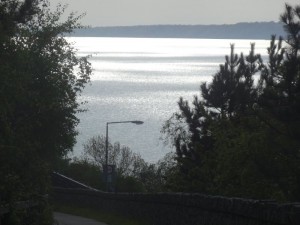 A story a little further on at page 29, ‘The danger of the sea‘, describes how Idris and Eddie were best friends, Idris working at a smithy and Eddie a bakery, both hot jobs. One day Eddie sets off to swim after work and gets cramp, Idris jumps in after him. Both are drowned, but when the bodies are found they still have their arms wrapped round each other.
A story a little further on at page 29, ‘The danger of the sea‘, describes how Idris and Eddie were best friends, Idris working at a smithy and Eddie a bakery, both hot jobs. One day Eddie sets off to swim after work and gets cramp, Idris jumps in after him. Both are drowned, but when the bodies are found they still have their arms wrapped round each other.
Along the coast I see signs warning of dangers to children and memorials to lost fishermen and lifeboatmen. The sea has been a major source of wealth for North Wales: laden stone transports, fishing and, in the days before good roads, much travel along the coast. However, the sea exacts her tithe of lives, whether in the clinging mud of the Dee estuary or the tidal surge through the Menai Straits.
Finally on page 30:
‘It isn’t possible for me to write merely about my family long ago there’s always something happening that I want to tell you about. It’s 11:30pm on April 1st, 2003. The war in Iraq is getting worse; women and children are getting killed there. Young men are losing their lives; fighting for who knows what. I hop that somehow, it’s all going to be worth it. It seems to me that there should be other ways in which so-called civilised people sort out their differences.”
I could not help but recall that plaque from the previous day commemorating 50 years of peace.
The last stretch of the day is just a few miles around another headland into Llanfairfechan (little church of Mary). The current walkway, which cuts back and forth across the A55 and railway, was only constructed in 2007. Before that it looks as if there was simply a small pavement beside the speeding traffic.
[added April 2014]
On the road into Llanfairfechan I pass a bright blue corrugated iron church, the ‘English Methodist Church‘. Looking at a scan of circuit records at the National Archive there was a separate English Methodist Circuit based in Bangor from at least 1832. I assume this would have been established for migrant workers at the nearby quarries in Penmaenmawr; during the Welsh Revival in 1904 reports say that "all the chapels had special prayer-meetings" and also, "The workmen also are having prayer meetings in the Penmaur Quarries at the dinner hour." However the English services must have become increasingly important as the Victorian love of seaside holidays grew; certainly letters in the records suggest the English circuit was important for visitors in the 1920s and 1930s when it clearly was under (unwelcome) pressure to merge with the Welsh circuit.
The tin church reminds me of my childhood church, Roath Park Methodist Church in Cardiff. It was an enormous stone building capable of holding 1500 people, but had originally been a corrugated iron building, affectionately known as the ‘tin tabernacle’, before the current building was built in the early years of the 20th century. However, that massive stone building is now closed and this plain blue corrugated iron building still open.
Although reminded of my Methodist roots, on this day these did not extend as far as temperance, and so I stopped off at the Village Inn for a local pint before heading back to the van. I saw that they served food and thought about returning later for dinner if they also had internet.
"Do you have WiFi", I asked at the bar.
Looking me straight in the eye, without a hint of sarcasm, "Oh we’re not that modern."


